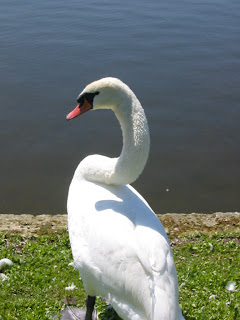First thing was to master the tram system,

which proved remarkably easy. A short walk through the train station—a notably clean and well organized affair: looking at the destinations of the sleek machines lined up at the platforms, Ellie began to dream of trips to Paris, Venice, Rome…—we found the tram stop that would take out to the fabulous, 17th century Scholss Nymphenburg and its surrounding park.
 We found a long elegant approach to the sumptuous palace, along waterways graced with dozens of swans ans well-stocked with fish.
We found a long elegant approach to the sumptuous palace, along waterways graced with dozens of swans ans well-stocked with fish.

We decided on the park first, and took a long walk through the formal gardens to where they gave way to natural forests,

lakes and meadows, dotted here and there with little “burgs”—a “pagoda” designed in Chinese style; a hunting lodge complete with chapel, one of the first, apparently, to be designed specifically as a “ruin”; a summery bathhouse with a huge, sunken indoor swimming pool dating from the eighteenth century; a lovely single-story lodge with richly baroque décor;


and a carriage house with huge, elaborately gilded carriages and sleds for the aristocratic family who once owned and lived in this extraordinary estate. It was when we reached the carriage house with its extravagant display of ostentatious transportation that I began to wonder: who did these people think they were? I like to think I would have been among the revolutionaries!
Back, via tram again, to the city center, where we walked from the Karolinenplatz with its dark obelisk to the Koenigsplatz,

a formal, neoclassical civic center whose vast open plazas and temple-like buildings evidently appealed to Hitler’s sense of pomp: it was here that the Nazi movement first took root and power. We passed an archeological site

where the basement of the “Brown House,” the Nazi party headquarters, was revealed, along with posters reminding the contemporary citizens of Munich that they still have some catching up to do with Berlin in un-burying the past. Ellie and I recalled our visit to the Terror Museum there, in Berlin, where they had dug out the old Gestapo headquarters from the rubble of World War II to act as a memorial to those who were imprisoned and tortured there.
Right on the corner of the Koenigsplatz, we came to the museum we had been looking for—the Lenbachhaus, former residence of an artist, now the repository of a stunning collection of art from the Blaue Reiter group from the early twentieth century: Wassily Kandinsky, Franz Marc, Paul Klee, Jawlensky, and many others whose names are less well known. As always, I was humbled to find outstanding paintings by artists whose names I did not even know. The small museum—a comfortable size to visit in a couple of hours and come away enriched—was also astounding in the adventurousness of its installation design. The floor of this Jawlensky room, for example, was slathered in neon rainbow colors
 which reached up the walls and playfully splashed over a mock painting, complete with mock descriptive label attached to the wall. Elsewhere the walls were brilliant pink, blue, green, and even a camouflage pattern of black and white.
which reached up the walls and playfully splashed over a mock painting, complete with mock descriptive label attached to the wall. Elsewhere the walls were brilliant pink, blue, green, and even a camouflage pattern of black and white.Besides the Blaue Reiter collection, we found an interesting contemporary wing, with works by Warhol, Joseph Beuys, Gerhard Richter and other luminaries, along with some interesting work by newer artists like Erwin Wurm, whose playful constructions using common articles of clothing are always surprising and delightful. We were the last ones out of the museum at six, and spent a few more minutes
 in the delightful, still sunlit garden that surrounds it. Then a long walk down broad, tree-lined avenues to the Alte Stadt, the old city—now much reconstructed,
in the delightful, still sunlit garden that surrounds it. Then a long walk down broad, tree-lined avenues to the Alte Stadt, the old city—now much reconstructed,  following the destruction of World War II—and spent a couple of hours wandering the streets.
following the destruction of World War II—and spent a couple of hours wandering the streets.
Dinner at a noisy beer hall filled with raucous football fans—celebrating some event of which we seemed to be the only ones uninformed. Good, simple fare: tasty Wiener sausages accompanied by a sweet-and-sour cabbage salad and a German potato salad; and a quick stop for gelato on the way back to







2 comments:
Great coverage P!
The Alte Pinotech there is one of the very best old masters museums in the world.
Thanks for the great photos from Munich, Peter.
When you get home you can go see the new Jawlensky exhibit at the Norton Simon.
Have fun!
Post a Comment